HIGHLIGHT OF APRIL 2014
This is the first study that quantifies the impact of wildfires in
the highly radioactive forests of Ukraine, Belarus and Russia on the
human population and the environment. Since the Chernobyl accident in
1986, extreme contamination of forests in Ukraine, Belarus and Russia
resulted in evacuation and lack of forest management. Currently,
trees cover more than 70% of these areas, and Climate Change suggests
increasing fire risks. These worrying findings call on the scientific
community and the European responsible authorities to study the consequences
of wildfire scenarios and quantify the health risks for humans and animals.
The global aerosol model LMDZORINCA was used to predict the 4D distribution
of 137Cs following the fire scenarios at a resolution of 0.66°×0.51°
(zoom centered over Europe) over 19 vertical layers. The spatial deposition
density of 137Cs (Bq m-2) in these forests is currently well known either
from measurement or modelling and is multiplied by the burnt area (m2) read
from MODIS to estimate 137Cs emissions. We estimate that up to 4.5 PBq of 137Cs
can migrate over Europe, which constitutes a serious accident in the
International Nuclear Events Scale (INES). A number between 20 and 240 may
suffer from solid cancers in Europe, of which 10 – 170 may be fatal.
This is very important if one takes into account that the global excess
lifetime fatalities from the recent accident in Japan have been estimated
to be between 220 to 520. Increased radiation levels have changed the animal
population regime in the area since 1986.
The situation near these forests will be exacerbated after a major fire,
due to the Chernobyl-remaining refractory elements (such as Pu and Am), also trapped there.
|
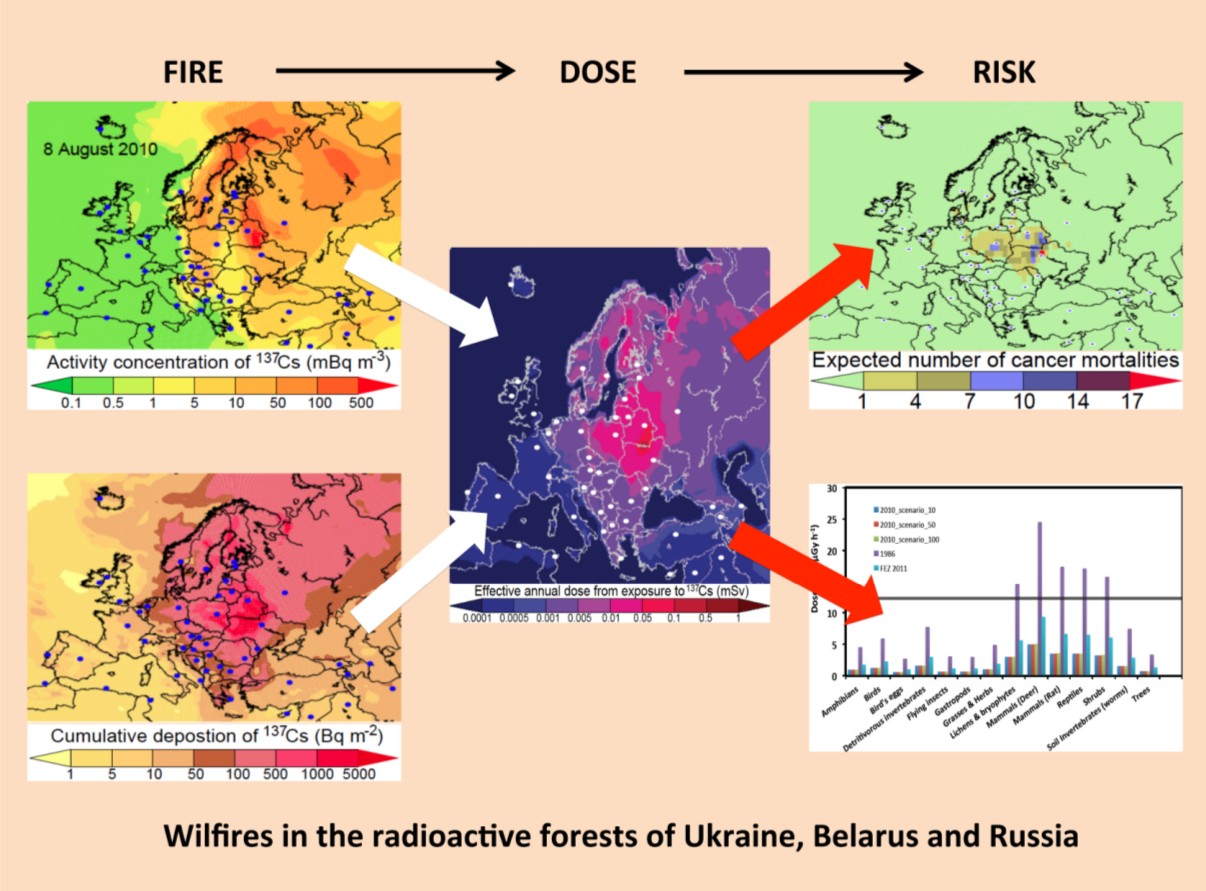
|
HIGHLIGHT OF NOVEMBER 2013
Description: Global death (or mortality) risk from radiation cancer
estimated after the Fukushima accident in Japan (2011).
Risks were calculated by combining relative risks and functions of
the Linear No-Threshold (LNT) model with the results of the LMDZORINCA
simulations for the accident. Two of the most important radionuclides,
that constitute the global fallout, have been examined (134Cs and 137Cs).
The resolution of the model version used here is 2.5ox1.3o over 39 vertical
levels. Our results showed that 360 - 850 cancer incidents are expected,
of which 220 - 520 may be fatal. This is the first reported map that
localizes cancer risk after Fukushima, whereas comparisons with other estimation
(e.g. Ten Hoeve and Jacobson, 2012) show excellent coherence of our results.
|

|
HIGHLIGHT OF october 2013
Atmospheric emission and transport of 137Cs after the major fires of 2002
inside Chernobyl's Exlcusion Zone and Belarusian forests as seen
from the LMDZORINCA model. The resolution of the present version is 0.66ox0.51o
over 19 vertical levels. Animation shows the 3-D representation of the
iso-surface of 137Cs for activity concentrations between 0 and 1 Bq/m3.
|
|
HIGHLIGHT OF June 2013
La minéralogie des poussières désertiques joue un rôle important dans le calcul
des effets radiatifs direct et indiract, en chimie hétérogène et pour les cycles
biogéochimiques. Cette minéralogie dépend en partie de la minéralogie des régions
sources de poussières et aussi de la fractionation en taille pendant les processus
d'érosion et de transport atmosphérique. Nous présentons dans ce travail une base
de données caractérisant les fractions argile et limon pour chaque type de sol
à l'échelle globale en terme d'abondance de 12 minéraux importants dans les
interactions poussière-climat : quartz, feldspath, illite, montmorillonite, kaolinite,
chlorite, vermiculite, mica, calcite, gypse, hématite, et goethite. L'information
minéralogique a été compilée à partir de données publiées dans des papiers scientifiques
et nous avons étendu cette base de données en appliquant des règles explicites.
afin de caractériser le plus grand nombre d'unités de sol posssibles.
Nous présentons trois réalisations de cartes minéralogiques, qui prennent en compte les
incertitudes des données minéralogiques. Nous analysons l'effet de ces variations
minéralogiques sur l'albédo de simple diffusion des poussières désertiques et donc sur leur forçage radiatif.
|

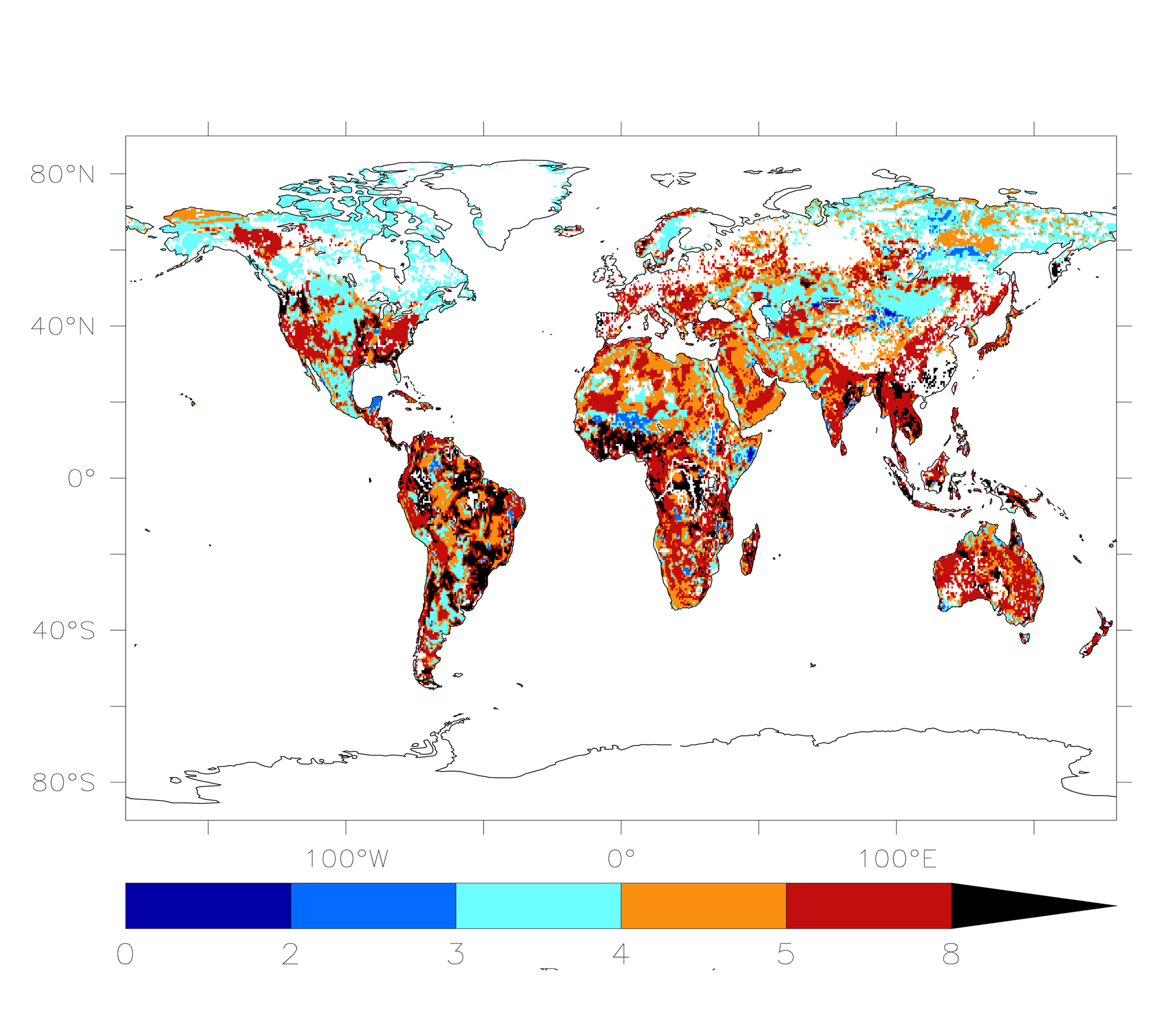
|
HIGHLIGHT OF April 2013
Simulation of the worldwide transport of 137Cs after the Fukushima Daiich Nuclear Power
Plant accident in Japan as a result of the earthquake and the tsunamis' attack
(March 11th, 2011). Three-dimensional representation of the iso-surface of 137Cs
(0.8 mBq m-3 STP). On the left panel the simulation of 144x142 configuration
over 19 levels is depicted, whereas in the right one the same simulation over
39 vertical levels. Red denotes increased activity concentrations, whereas
green lower ones (range of the iso-surface 0-1.6 mBq m-3 STP). The activity
concentrations are expressed in Bq per m3 STP, where m3 STP is a standard
cubic meter of air at 273.15 oK temperature and 1 atm pressure.
|
|
HIGHLIGHT OF February 2013
Relative contribution (%) of aircraft (blue), shipping (yellow),
and road (red) emissions to boundary layer ozone increase due to
transport in Europe and in the United States in 2050 under business
as usual scenario A1B (left) and the mitigation scenario B1 ACARE (right).
The ozone change is integrated from the ground level to the pressure
of 910 hPa (lowest three model levels). Hauglustaine and Khoffi (2012).
|
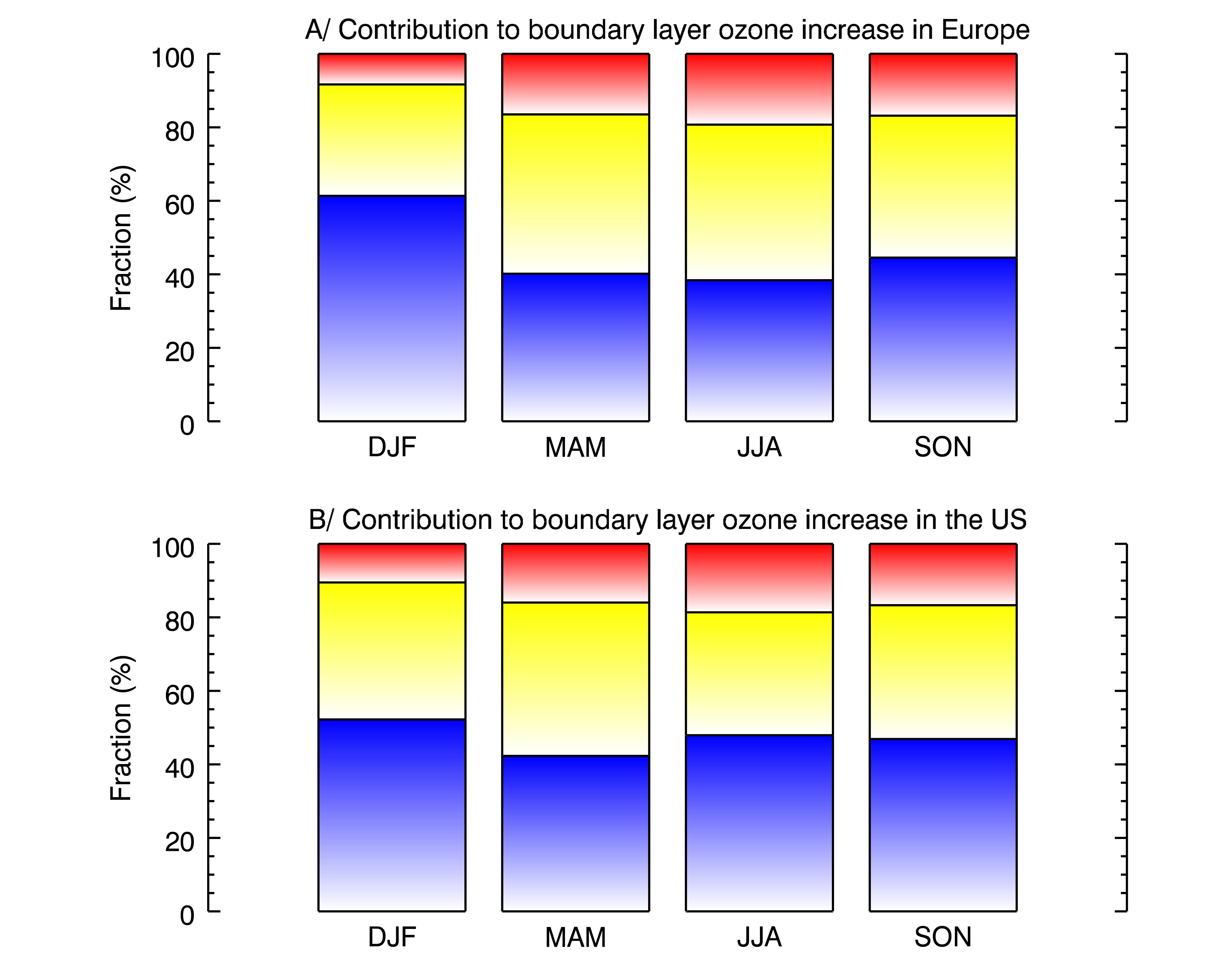
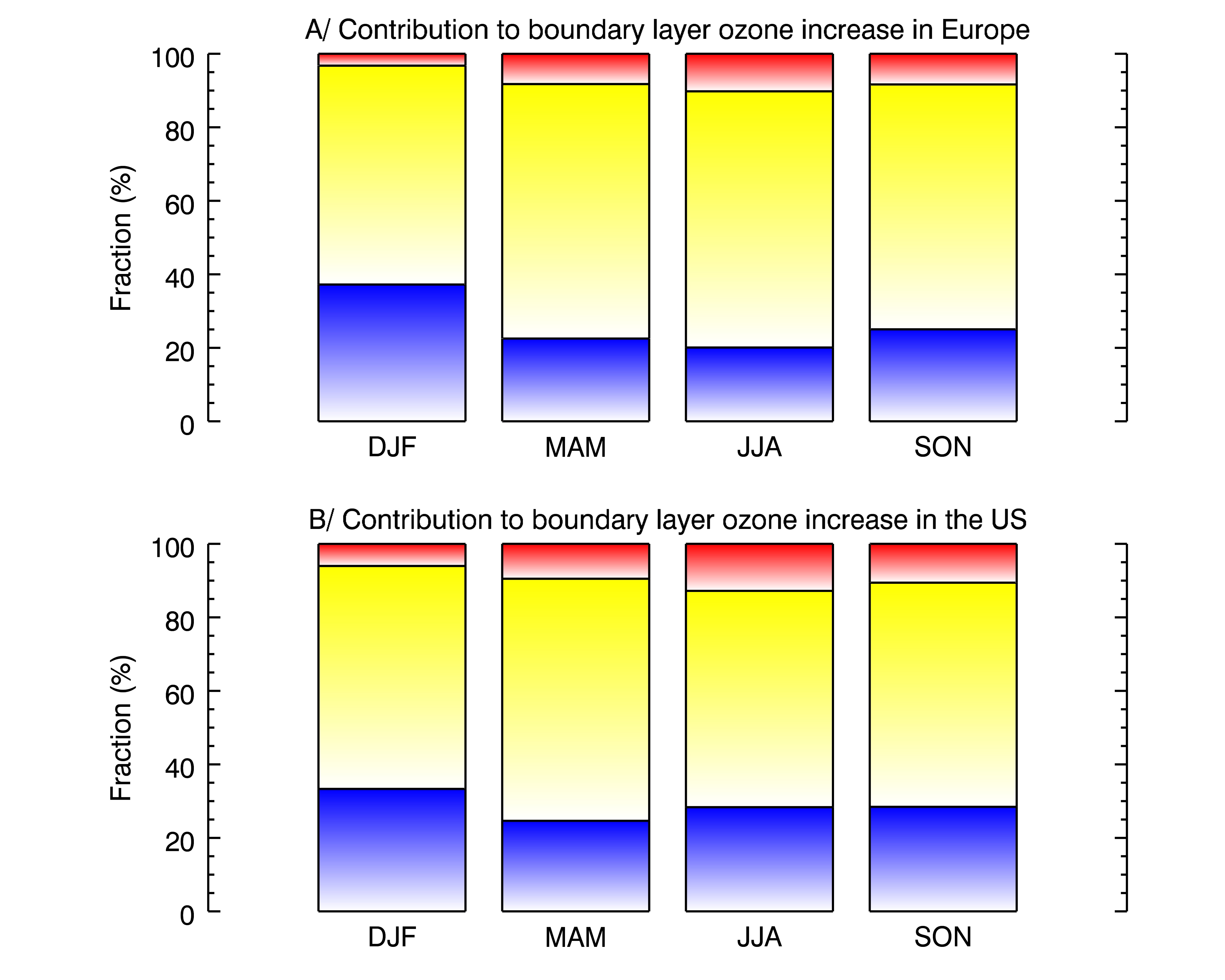
|
HIGHLIGHT OF NOVEMBER 2009
Model simulations, climatologies, and integrated products
Simulated 4D European and global climatologies of reactive gases
and aerosol fields are available at
(http://www.geomon.eu/science/act5/SciAct5_MOD_WP2.html).
They concern both stratospheric and tropospheric contents.
Two of these climatologies are obtained from model ensemble
simulations (from the RETRO and AEROCOM projects).
The Air Quality climatology for O3 and aerosols was provided
by INERIS based on the Prev'air system combining CHIMERE model
results and surface observations.
Comparisons between CARIBIC measurements and LMDz-INCA simulations
of acetone concentrations are on-going. Measurements acquired onboard
a commercial airplane in the framework of the CARIBIC Project
(http://www.caribic-atmospheric.com/) are superimposed to simulated
daily means, generated with the global CTM LMDz-INCA running at a
3.75°x2.5° horizontal resolution
(http://lmdz.lmd.jussieu.fr/applications/projets/inca, http://www-lsceinca.cea.fr/)
in Figure 1.
The selected flight is made from Santiago De Chile (Chile) to Frankfurt (Germany),
via Sao Paulo (Brazil) on 21 March 2006. Around 15°N, the airplane crosses a
plume of acetone extending from northern South America to Africa.
Figure 2, based on instantaneous simulated results interpolated online to the
flightracks, shows a good agreement between measurements and simulations.
In particular the plume where acetone concentration reaches 700 ppt between
10 and 20°N is reproduced (Figures 2a and 2b), as well as the concentration
level of around 500 ppt on eastern South America in the flight to Sao Paulo
(Figure 2a), and the change of acetone concentration of more than 100 ppt over
the North Atlantic Ocean (for latitude larger than 20°) during the flight back (Figure 2b).
This work will be pursued by sensitivity tests of LMDz-INCA to sources and sinks
in order to improve the agreement of modelling with observation and extended to CO
and CH4 comparions with the TM5 model.
contacts: T. Elias (thierry.elias lsce.ipsl.fr) & S. Szopa (sophie.szopa lsce.ipsl.fr) & S. Szopa (sophie.szopa lsce.ipsl.fr) lsce.ipsl.fr)
|
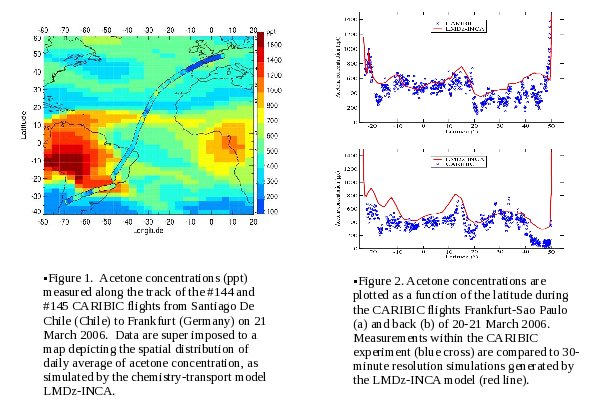 |
HIGHLIGHT OF APRIL 2008
Zonal mean CH3OH volume mixing ratio profiles observed
by the ACE-FTS (left) and simulated with the LMDz-INCA
model (right) for each season from March 2004 to August
2005. The modeled profiles used are interpolated at the
measurement locations. The number of profiles averaged
in each 20° latitude band is indicated on the left
panels (white squares). Only averages with more than
10 profiles are displayed. A mean tropopause height
is calculated based on NCEP meteorological fields for
each measured methanol profile and from the model for
the calculated distributions (white line).
Dufour et al., ACP, 2007
|
 |
HIGHLIGHT OF NOVEMBER 2007
The dust forecast performed daily with the experimental
INCA chemical weather forecast is compared to the
Aeronet sun photometer measurements in Dakar,M'Bour,Africa
(acknowledgement Didier Tanre LOA). The analysis of the
initialisation day (J0) and of the forecast +2 days (J2)
and +5 days (J5) is compared to the 2006 annual cycle of
aerosol optical depth. Despite a degradation of the
AOD forecast with increasing time forecasted the global model can
reproduce the general characteristics of the dust appearance
at the borders of the Sahara.
|
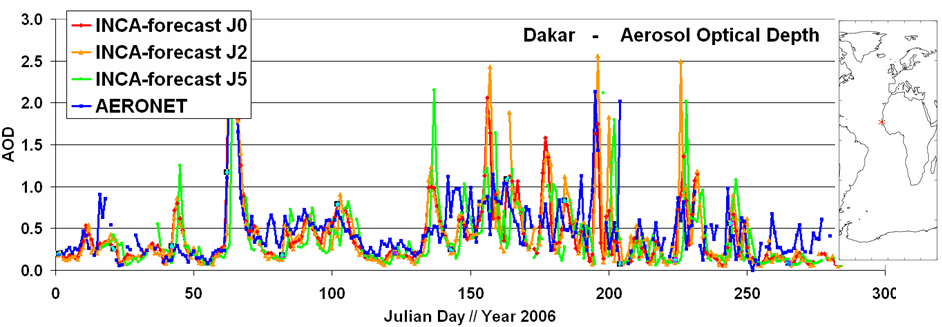 |
|
HIGHLIGHT OF JANUARY 2007
|
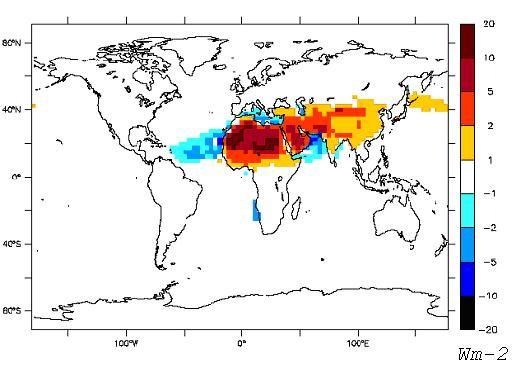
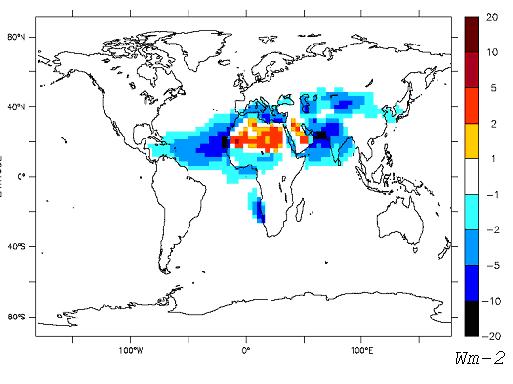
|
Comparaison de l'effet radiatif des poussières tel que calculé
auparavant en utilisant l'indice de réfraction proposé par
Patterson and Volz (à droite) et avec les calculs optiques
d'un mélange interne compose de 1.5% en volume d'hématite (à gauche).
Modélisation et observations satellite permettent de contraindre
l'effet radiatif des poussières minérales
Des chercheurs du LSCE ont récemment réduit l'incertitude sur
l'effet radiatif des poussières minérales, l'une des plus grandes
incertitudes des composants à effet de serre sur le bilan global de la planète.
En recalculant les propriétés optiques, ils ont pu expliquer le désaccord
qui existait entre modélisation et observations par satellite sur le signe
et l'amplitude du forçage radiatif dû aux aérosols minéraux.
L'étude démontre que les poussières minérales seraient globalement
responsables d'un faible refroidissement de la planète,
avec toutefois un réchauffement local en Afrique saharienne.
l'incertitude sur ce forçage aurait été réduite d'un facteur trois
par rapport à celle publiée en 2001 par le Groupe d'experts
intergouvernemental sur l'Evolution du Climat.
Contacts : Yves Balkanski, Michael Schulz
|
HIGHLIGHT OF JUNE 2006
Individual contributions of the five aerosol components
(SS-seasalt, DU-dust, POMparticulate organic matter,
BC-black carbon, SU-sulfate) to the annual global aerosol
optical thickness at 550nm (AOD) from different
AeroCom
models as compared to Aeronet (Ae) sun photometer and a
satellite composite (S*) observations (From Kinne et al. 2006).
LS represents the INCA model simulation. The models have quite a different
understanding of how to derive global AOD from aerosol components.
The just published AeroCom papers
Kinne et al. ACP, 2006 and
Textor et al. ACP, 2006
document considerable diversity in global aerosol models
and the need to further improve aerosol parameterizations.
|
 |
HIGHLIGHT OF FEBRUARY 2006
Monthly mean surface O3 changes in July 2030 (compared with July 2001) (a)
at the global scale using LMDzINCA, for the "current legislation" scenario;
(b)(c)(d) over Europe using the regional CTM CHIMERE forced with LMDzINCA boundary
conditions, for, respectively, the "current legislation" scenario, the
"maximum feasible reductions" scenario and the SRES-A2 scenario.
(Sophie Szopa et al., GRL submitted in January)
|
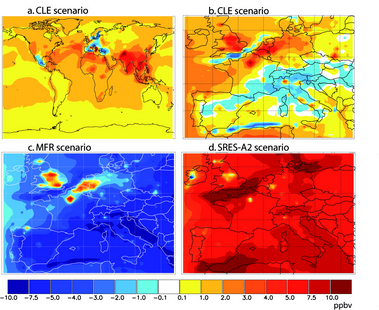 |
HIGHLIGHT OF NOVEMBER 2005
A first simulation of the Antarctic ozone hole formation with the 50 level
version of the coupled chemistry-climate model LMDz-INCA
including the stratospheric gas phase and heterogeneous chemistry.
The figure shows the onset of the polar vortex and the formation of
the ozone hole for 1990 Cl and Br conditions. A maximum ozone
destruction with total ozone column as low as 150-175 DU is reached
in mid-october October. The dilution of the ozone hole appears in
November-December. (Contact: D. Hauglustaine, LSCE).
|
 |
|
HIGHLIGHT OF OCTOBER 2005
|
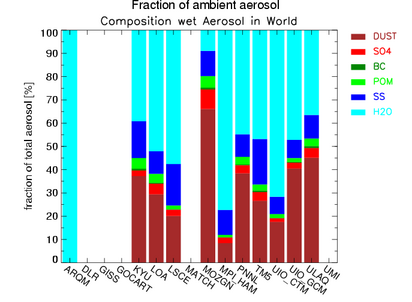
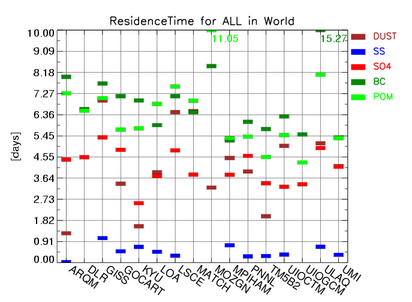
|
Simulation results of global aerosol models have been assembled
in the framework of the AeroCom intercomparison exercise.
The life cycles of dust, sea salt, sulfate, black carbon and
particulate organic matter as simulated by sixteen global aerosol
models. The diversities among the models for the sources and sinks,
burdens, particle sizes, water uptakes, and spatial dispersals have
been established. The established diversities are highest for:
the coarser aerosol types (sea salt and dust)
long-range transport towards the poles,
the split between convective and stratiform wet deposition,
total aerosol composition and water uptake,
vertical aerosol dispersivity and mass in the free troposphere
masses of aerosol in the radiatively active fine mode
The latter three topics are particularly relevant for aerosol radiative
forcing calculations. As examples we show the residence times for the five
species under consideration and the compositions of ambient aerosol as
simulated by 16 models.
For further information see
http://nansen.ipsl.jussieu.fr/AEROCOM.
|
HIGHLIGHT OF SEPTEMBER 2005
Horizontal distribution of the annual mean in situ CO2 production rate
for (left) the CO channel and (right) the radicals and ozonolysis channel.
(top) Column integrated production rates (10**-9 TgC km**-2 yr**-1);
(bottom) annual mean production rates at the surface (10**5 molecules
cm**-3 yr**-1). Results are taken from the lowermost model level representing
a layer height of approximately 140 meters. (see full description in
G. Folberth, D. A. Hauglustaine, P. Ciais, and J. Lathière,
On the role of atmospheric chemistry in the gloabl CO2 budget, 2005)
|
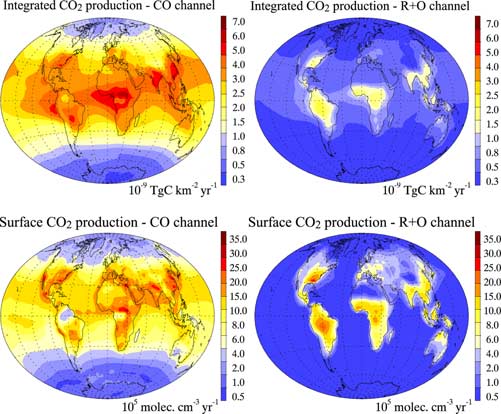 |
HIGHLIGHT OF SUMMER 2005
Annual global OH anomalies from mean inversion (solid line) compared
with estimates from Prinn et al. (2001) (a) and from Krol et al. (2003)
(b). Grey zone is the envelope of all 16 inversions. (see full description
in P. Bousquet, D. A. Hauglustaine, P. Peylin, C. Carouge, and P.
Ciais, Two decades of OH variability as inferred by an inversion
of atmospheric transport and chemistry of methyl chloroform, 2005)
|
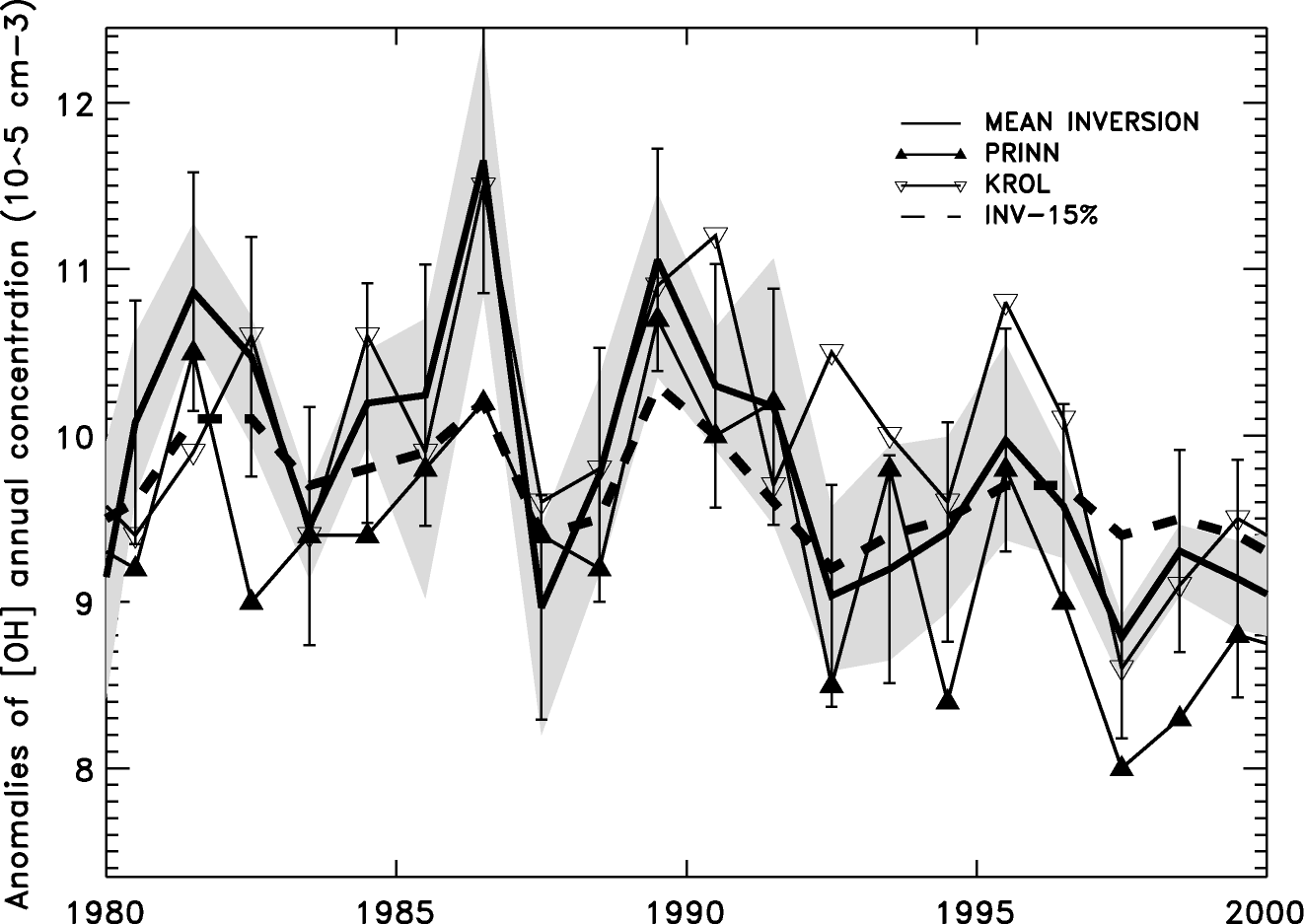 |
HIGHLIGHT OF APRIL 2005
Simulation with INCA of vertical aerosol extinction profile at EARLINET
site Hamburg, for year 2000. Observations taken by the lidar group, Jens
Boesenberg, Volker Matthias and colleagues from the Max-Planck Institute
of Hamburg. The averaging over longer periods provides a stable way to compare
global model results with local lidar observations. (see full description
in Guibert, S., V. Matthias, M. Schulz, J. Bösenberg, R. Eixmann,
I. Mattis, G. Pappalardo, M. R. Perrone, N. Spinelli, and G. Vaughan ,The
vertical distribution of aerosol over Europe - Synthesis of one year of
EARLINET aerosol lidar measurements and aerosol transport modeling with
LMDzT-INCA, Atmos. Environ., in press, 5. ) |
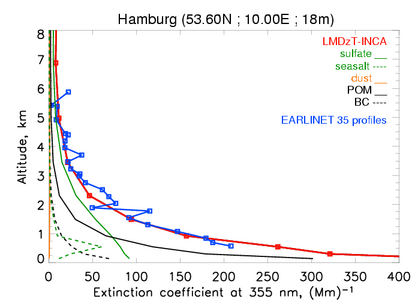 |
| |
|
| ©
Laboratoire des Sciences du Climat et de l'Environnement
|
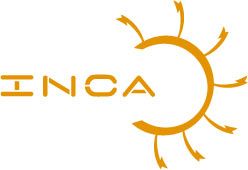 LMDzt-INCA
(Interaction of chemistry and aerosol)
LMDzt-INCA
(Interaction of chemistry and aerosol)
 LMDzt-INCA
(Interaction of chemistry and aerosol)
LMDzt-INCA
(Interaction of chemistry and aerosol)








